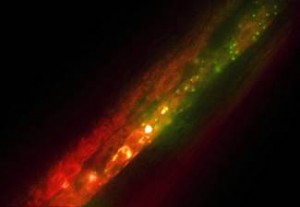Tagged: photonics
Light-Up Brains
Studying neurological disorders and identifying the brain regions associated with them often involves selective activation and deactivation of neurons. Blue light has been used in the past to activate cells, but recently Stanford University neuroscientists have figured out a way to use different colors of light to inhibit neurons. Their growing area of research, optogenetics, involves the engineering of viruses that insert genetic coding for light-sensitive proteins into cells of interest.
In the 2 April 2010 issue of Cell, Karl Deisseroth and his colleagues at Stanford published a study demonstrating the use of near-infrared wavelengths in neuron inhibition. Infrared light, being at a higher wavelength than blue light, delivers less energy to tissues and is safe at low power. Its ability to reach deeper brain regions, and thus cover more volume, is useful in in-vivo experiments. Additionally, using different colors of light to alter the activity of different brain regions at the same time could provide some answers as to how changes in various regions work in conjunction with each other to cause neurological problems. Optogenetic technology is already being used in research to study motor control, reward, addiction and other neuropsychiatric disorders.
Switching brain cells on and off using multicolored light – Marie Freebody
Molecular and Cellular Approaches for Diversifying and Extending Optogenetics – Article in Cell
